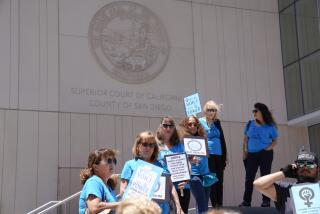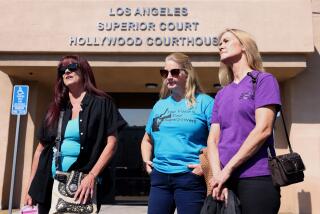Public Getting Information on 63,900 Sex Offenders
California residents will have an unprecedented chance to learn the whereabouts of 63,920 of the state’s convicted sex offenders starting next Tuesday.
But even as Atty. Gen. Dan Lungren today unveils a publicly accessible sex offender database created under Megan’s Law, police across the state are still bedeviled by several significant problems, including incomplete data on offenders and ill-defined policies on how to tell residents about them.
“Every phase of Megan’s Law seems to have an incredible amount of difficult issues to deal with, but we’re just trying to muddle through,” said Santa Cruz Sheriff’s Det. Latisha Marshall. “We’re just waiting for the first lawsuit.”
California law for years has required sex offenders to register their addresses with local police. Megan’s Law requires the information about most sex offenders to be compiled in a database open to public view and enables police to publicize the offenders’ whereabouts.
Atty. Gen. Dan Lungren will demonstrate the CD-ROM at a Los Angeles news conference today. But amid the crush of attention to the database, fundamental problems have emerged.
* The database may be up to 40% inaccurate, listing sex offenders long dead, incarcerated or dodging annual registration.
* The law allows police to publicize the names, pictures and addresses of convicted sex offenders. But authorities fear that that prospect may drive more criminals underground and overzealous citizens to vigilantism.
* While some departments--such as the Los Angeles County Sheriff’s Department--are ready to make public next week the names and photographs of the most dangerous local sex offenders, many others, such as the Los Angeles Police Department, still lack concrete policies on how to notify the public about sex offenders.
Lungren has touted Megan’s Law, named after a 7-year-old New Jersey girl slain by a paroled child molester living on her street, as an unprecedented chance to provide parents with information that they can use to protect themselves and their children. But a deep ambivalence about the law appears to run through the state, with even advocates saying they expect limited use of the databases.
“To take all your soccer coaches and look them up before the . . . season, that’s not going to happen,” said Jayne Murphy Shapiro, president of Kids Safe and a driving force behind the passage of Megan’s Law. “I don’t think anyone’s going to be in line waiting to get into the police departments” to look at the CD-ROM.
Perhaps the population most interested in the law is sex offenders themselves. Police departments report that child molesters are inquiring about how aggressively the law will be enforced in their cities. In Long Beach, one molester was especially interested in how tough the city would be because he wanted to buy a house there.
*
State officials say Megan’s Law remains the best defense against sex criminals.
“The value still remains that we’re lifting the veil on sex offenders’ ability to exist in communities anonymously,” said Rob Stutzman, spokesman for Lungren. “It’s the best resource that has ever been available to the public.”
The database will contain the names and descriptions of sex offenders. Although police will be able to view the criminals’ home addresses, the public portion of the CD-ROM will only list ZIP codes. In 80% of the entries, photographs of the offenders are available.
For the past nine months, state Department of Justice workers and police statewide have been scrambling to assemble the CD-ROM by the July 1 deadline. But the finished product remains flawed, officials acknowledged.
State officials told The Times in February that an estimated 20% of California’s offenders were unaccounted for.
But Stutzman said Thursday that the previously released figure did not include thousands of other offenders who never registered or became lost in police files.
Now state officials estimate that as many as 40% of the offenders may be unaccounted for.
The database includes 4,500 offenders whose whereabouts are listed as “unknown.” Of those, 148 are “high-risk” offenders.
Police in Anaheim, Long Beach and San Francisco have found deceased sex offenders listed in test versions of the state’s CD-ROM. One convicted sex offender, Harvey Bess, was listed as living in Long Beach even though he hanged himself with a towel in Men’s Central Jail a year ago.
The latest prototypes list about 9,000 sex offenders believed to be living in Los Angeles, but the LAPD has records of only 2,574. In Long Beach, the CD-ROM lists 1,400, even though the police there have only 850. San Diego police have records of 2,000 sex offenders in their city while the state list has 2,800.
“The information is not going to be very accurate,” San Diego Police Lt. Jim Barker said, “especially on the first edition.”
Part of the reason for that, police say, is that sex offenders are criminal by nature and do not want to leave a trail. This problem has worsened since Megan’s Law was adopted last fall because sex offenders do not want to be exposed by police, according to a state Department of Justice task force that tracks down errant offenders.
Since the law went into effect, police across the state have alerted neighborhoods to a handful of sex offenders living in their midst. In most cases, the sex offenders have fled because of neighborhood protests and media scrutiny.
As Tuesday’s deadline for the CD-ROM rolls around, departments are scrambling to finalize their policies on notification. Some police fear that this will drive more sex offenders underground.
Los Angeles County Sheriff Sherman Block said that as of Tuesday, fliers identifying many of the county’s 330 highest-risk sex offenders--those with multiple violent offenses--will be available in sheriff’s stations and libraries.
*
A similar policy has led to problems in Santa Cruz County, which sent out fliers on its five high-risk offenders earlier this year.
“A year ago I knew where all my high-risk offenders were. They were all employed and living in a home,” said Marshall, the Santa Cruz detective. “Now I don’t know where they sleep any given night. . . . They’re moving around sleeping in cars, which is not what you want your sex offenders to be doing.”
Most sex crimes “deal with issues of power and control,” said Long Beach Police Detective J. Craig Newland. When a sex offender is released from prison and becomes subject to public notification, “he can’t live anywhere and he can’t work anywhere. They’re losing control over their own lives. What we may be doing is making it so they need to rape another woman or molest another child.”
With that in mind, Long Beach police have made two low-profile notifications in recent months--on a piano teacher who advertised he was “Excellent with children” and a molester who took two boys on sailing trips.
In each case, police only notified the parents of the affected children and were able to avoid a public outcry. This means, they say, that they will proceed cautiously on a case-by-case basis in the future.
The LAPD also says it does not yet have a concrete policy and plans to handle notifications on a case-by-case basis.
Policies on how much access the public will have to the CD-ROM differ among departments. The disk will be available to all sheriffs’ departments and to police departments in cities with populations over 200,000. In Los Angeles County, that includes only the LAPD and the Long Beach Police Department.
Block said Megan’s Law computers will be placed in each sheriff’s station, but can only be used for 15 minutes per person. LAPD officials plan to place terminals in only four stations--Van Nuys, Central, Harbor and West Los Angeles--but have not finalized plans on whether to limit access. In Long Beach, it will be kept in a detective’s office.
As publicity bubbles about the database, some of the organizations that state authorities had expected to use the information say they do not intend to view the CD-ROM.
“It would kind of be overkill,” said Joan Mullins, an assistant director at the Childtime Daycare Center in Long Beach, one of a national chain of child-care facilities. She said Childtime schools already run extensive background checks on their employees.
“I think Megan’s Law is kind of a Catch-22 anyway,” Mullins said. “If we want to let these people out of jail, we shouldn’t hound them after they get out.”
More to Read
Sign up for Essential California
The most important California stories and recommendations in your inbox every morning.
You may occasionally receive promotional content from the Los Angeles Times.










